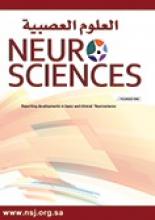Research ArticleOriginal Article
Open Access
Evaluation of adherence to pediatric status epilepticus management guidelines in Saudi Arabia
Bashayer A. AlMohaimeed, Khaled J. Hundallah, Fahad A. Bashiri, Sulaiman A. AlMohaimeed and Brahim M. Tabarki
Neurosciences Journal July 2020, 25 (3) 182-187; DOI: https://doi.org/10.17712/nsj.2020.3.20190106
Bashayer A. AlMohaimeed
From the Division of Pediatric Neurology (AlMohaimeed B, Hundallah, Tabarki), Division of Pediatric Critical Care (AlMohaimeed S), Prince Sultan Military Medical City, and from the Division of Neurology (Bashiri), Department of Pediatrics, College of Medicine, King Khalid University Hospital, King Saud University, Riyadh, Kingdom of Saudi Arabia
MDKhaled J. Hundallah
From the Division of Pediatric Neurology (AlMohaimeed B, Hundallah, Tabarki), Division of Pediatric Critical Care (AlMohaimeed S), Prince Sultan Military Medical City, and from the Division of Neurology (Bashiri), Department of Pediatrics, College of Medicine, King Khalid University Hospital, King Saud University, Riyadh, Kingdom of Saudi Arabia
MDFahad A. Bashiri
From the Division of Pediatric Neurology (AlMohaimeed B, Hundallah, Tabarki), Division of Pediatric Critical Care (AlMohaimeed S), Prince Sultan Military Medical City, and from the Division of Neurology (Bashiri), Department of Pediatrics, College of Medicine, King Khalid University Hospital, King Saud University, Riyadh, Kingdom of Saudi Arabia
MDSulaiman A. AlMohaimeed
From the Division of Pediatric Neurology (AlMohaimeed B, Hundallah, Tabarki), Division of Pediatric Critical Care (AlMohaimeed S), Prince Sultan Military Medical City, and from the Division of Neurology (Bashiri), Department of Pediatrics, College of Medicine, King Khalid University Hospital, King Saud University, Riyadh, Kingdom of Saudi Arabia
MDBrahim M. Tabarki
From the Division of Pediatric Neurology (AlMohaimeed B, Hundallah, Tabarki), Division of Pediatric Critical Care (AlMohaimeed S), Prince Sultan Military Medical City, and from the Division of Neurology (Bashiri), Department of Pediatrics, College of Medicine, King Khalid University Hospital, King Saud University, Riyadh, Kingdom of Saudi Arabia
MD
References
- ↵
- Pujar SS,
- Martinos MM,
- Cortina-Borja M,
- Chong WKK,
- De Haan M,
- Gillberg C,
- et al.
- ↵
- Gurcharran K,
- Grinspan ZM
- ↵
- Hommady RH,
- Alrifai MT,
- Mubayrik OK,
- Alayed RS,
- Alsemari MA,
- Arumayyan A,
- et al.
- ↵
- Al-Shamy S,
- Hosny AO,
- Ismail MT,
- Alsekaya MS,
- Abdeldayem M
- ↵
- Bashiri FA,
- Hamad MH,
- Amer YS,
- Abouelkheir MM,
- Mohamed S,
- Kentab AY,
- et al.
- ↵
- Glauser T,
- Shinnar S,
- Gloss D,
- Alldredge B,
- Arya R,
- Bainbridge J,
- et al.
- ↵
- Siefkes HM,
- Holsti M,
- Morita D,
- Cook LJ,
- Bratton S
- ↵
- Hill CE,
- Parikh AO,
- Ellis C,
- Myers JS,
- Litt B
- ↵
- Tourigny-Ruel G,
- Diksic D,
- Mok E,
- McGillivray D
- ↵
- Abend NS,
- Loddenkemper T
- ↵
- Uppal P,
- Cardamone M,
- Lawson JA
- ↵
- Kaputu K,
- Birindabagabo J,
- Mafuta M,
- Walker T,
- Misson JP
- ↵
- von Elm E,
- Altman DG,
- Egger M,
- Pocock SJ,
- Gøtzsche PC,
- Vandenbroucke JP,
- STROBE Initiative
- ↵
- Appleton R,
- Macleod S,
- Martland T
- ↵
- Uppal P,
- Cardamone M,
- Webber C,
- Briggs N,
- Lawson JA
- ↵
- Chin RF,
- Verhulst L,
- Neville BG,
- Peters MJ,
- Scott RC
- ↵
- Braun J,
- Gau E,
- Revelle S,
- Byrne L,
- Kumar A
- ↵
- Tobias JD,
- Berkenbosch JW
- ↵
- Tirupathi S,
- Mcmenamin JB,
- Webb DW
- ↵
- Gaínza-Lein M,
- Fernández IS,
- Jackson M,
- Abend NS,
- Arya R,
- Brenton JN,
- et al.
- ↵
- Kämppi L,
- Mustonen H,
- Soinila S
- ↵
- Unterberger I
- ↵
- Stredny CM,
- Abend NS,
- Loddenkemper T
- ↵
- Malakooti MR,
- McBride ME,
- Mobley B,
- Goldstein JL,
- Adler MD,
- McGaghie WC
- ↵
- Karbach U,
- Schubert I,
- Hagemeister J,
- Ernstmann N,
- Pfaff H,
- Höpp HW
- ↵
- Fischer F,
- Lange K,
- Klose K,
- Greiner W,
- Kraemer A
In this issue
Neurosciences Journal
Vol. 25, Issue 3
1 Jul 2020
Evaluation of adherence to pediatric status epilepticus management guidelines in Saudi Arabia
Bashayer A. AlMohaimeed, Khaled J. Hundallah, Fahad A. Bashiri, Sulaiman A. AlMohaimeed, Brahim M. Tabarki
Neurosciences Journal Jul 2020, 25 (3) 182-187; DOI: 10.17712/nsj.2020.3.20190106
Jump to section
Related Articles
- No related articles found.
Cited By...
- No citing articles found.





